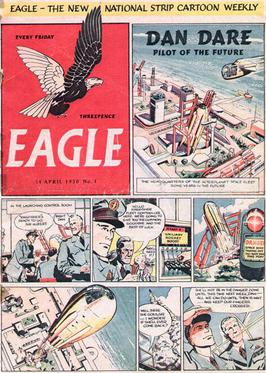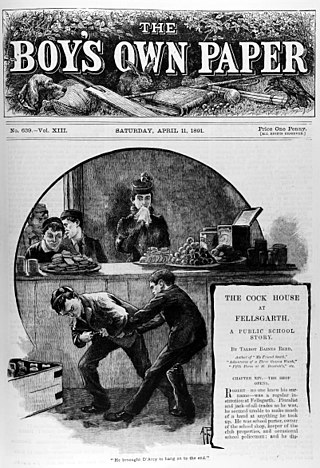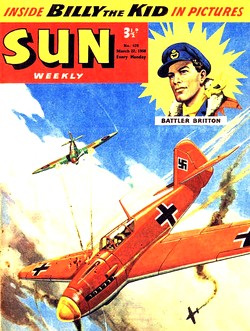The Beano is a British anthology comic magazine created by Scottish publishing company DC Thomson. Its first issue was published on 30 July 1938, and it published its 4000th issue in August 2019. Popular and well-known comic strips and characters include Dennis the Menace, Minnie the Minx, The Bash Street Kids, Roger the Dodger, Billy Whizz, Lord Snooty and His Pals, Ivy the Terrible, General Jumbo, Jonah, and Biffo the Bear.

A British comic is a periodical published in the United Kingdom that contains comic strips. It is generally referred to as a comic or a comic magazine, and historically as a comic paper.

Eagle was a British children's comics periodical, first published from 1950 to 1969, and then in a relaunched format from 1982 to 1994. It was founded by Marcus Morris, an Anglican vicar from Lancashire. Morris edited a Southport parish magazine called The Anvil, but felt that the church was not communicating its message effectively. Simultaneously disillusioned with contemporary children's literature, he and Anvil artist Frank Hampson created a dummy comic based on Christian values. Morris proposed the idea to several Fleet Street publishers, with little success, until Hulton Press took it on.
Ronald George Smith was an English comic artist whose career spanned almost fifty years. Primarily producing strips for the two main publishers, DC Thomson and IPC Magazines, Smith was best known for drawing Judge Dredd for 2000 AD and the Daily Star.
Classics from the Comics was a British comics magazine, published from March 1996 until October 2010. Published monthly, it was D. C. Thomson & Co. Ltd's third all-reprint comic. It replaced The Best of Topper and The Best of Beezer, which had reprinted old strips for some years.

The Shield is the name of several superheroes created by MLJ. Appearing months before Captain America, the Shield has the distinction of being the first superhero with a costume based upon United States patriotic iconography. The character appeared in Pep Comics from issue #1 to #65.

The Magnet was a British weekly boys' story paper published by Amalgamated Press. It ran from 1908 to 1940, publishing a total of 1,683 issues.
A story paper is a periodical publication similar to a literary magazine, but featuring illustrations and text stories, and aimed towards children and teenagers. Also known in Britain as "boys' weeklies", story papers were phenomenally popular before the outbreak of the Second World War.

War Picture Library was a British 64-page "pocket library" war comic magazine title published by Amalgamated Press/Fleetway for 2103 issues. Each issue featured a complete story, beginning on 1 September 1958 with "Fight Back to Dunkirk" and finishing 26 years later on 3 December 1984 with "Wings of the Fleet". The editor was Ted Bensberg. Assistant editors included Geoff Kemp and Brian Smith. Other editorial staff included Pat Brookman, Terence Magee, Clive Ranger, Tony Power and Clive McGee. Art editor was Mike Jones and art assistant was his brother Dave Jones. Other art assistants at various times were Roy McAdorey, Geoff Berwick, Bill Reid and John Fearnley.

Magazines intended for boys fall into one of three classifications. These are comics which tell the story by means of strip cartoons; story papers which have several short stories; and pulp magazines which have a single, but complete, novella in them. The latter were not for the younger child and were often detective or western in content and were generally greater in cost. Several titles were published monthly whereas the other two categories were more frequent.
Wilson the Wonder Athlete was a British comic strip, first published in 1943 in the British illustrated story paper The Wizard published by D. C. Thomson & Co. It follows the sporting adventures of a heroic character named William Wilson. The stories were written by Gilbert Lawford Dalton and drawn by Jack Glass. The stories ran until 1984 in various British magazines.
The Hornet was a British boys' comic published by D. C. Thomson & Co. for 648 issues from 14 September 1963 to 7 February 1976, after which it was merged with The Hotspur. The free gift with the first issue was a balsa wood "Kestral Glider".
William Sampson or Samson, the Wolf of Kabul, was a literary character in British boys' papers published by D. C. Thomson & Co. He first appeared in The Wizard in 1922.
Robert Duncan Low was a Scottish comics writer and editor. Employed by D. C. Thomson & Co., he was responsible for their line of comics, and, as a writer, co-created Oor Wullie and The Broons with artist Dudley D. Watkins.
Denis Gifford was a prolific comic artist and writer, most active in the 1940s, 50s and 60s. Gifford's work was largely of humour strips in British comics, often for L. Miller & Son. He was an influential comics historian, particularly of British comics from the 19th century to the 1940s.

Knockout was a weekly British comics periodical published by Amalgamated Press and later Fleetway Publications and IPC Magazines from 4 March 1939 to 16 February 1963. A boys' adventure comic, the title ran for 1227 issues before being merged with Valiant.
British girls' comics flourished in the United Kingdom from the 1950s through the 1970s, before beginning to decline in popularity in the 1980s and 1990s. Publishers known for their girls' comics included DC Thomson and Fleetway/IPC. Most titles appeared weekly, with the content primarily in picture-story format. The majority of the stories were serialized, with two or three pages per issue, over eight to twelve issues. They were marketed toward young teen girls.

Girls' Crystal was a British weekly fictional anthology publication aimed at girls. Published by Amalgamated Press and later Fleetway Publications from 26 October 1935 to 18 May 1963. Uniquely for an Amalgamated Press title, Girls' Crystal began as a story paper before transforming into a picture comic between editions, with the new format debuting on 21 March 1953. It ran for a combined total of 1432 issues before merging with School Friend in 1963.

Sun was a weekly British comics periodical published by J. B. Allen, Amalgamated Press and Fleetway Publications between 11 November 1947 and 17 October 1959. During this time it was also known as Sun Comic, Sun Adventure Weekly, The Cowboy Sun Weekly, The Cowboy Sun, The Sun and Sun Weekly at various points, and ran for 551 issues before merging with Lion.









